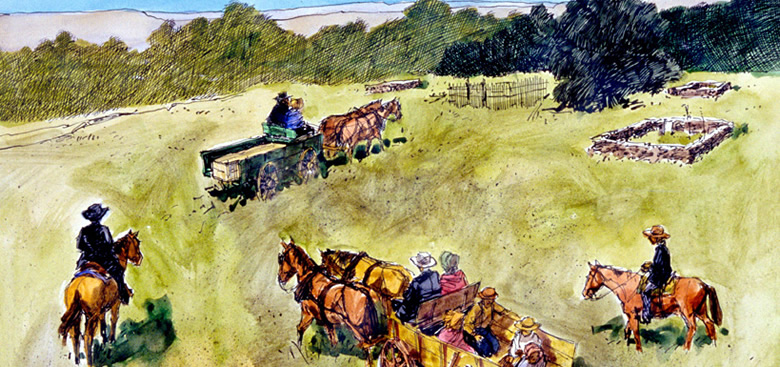
Stone grave enclosures of this late
nineteenth-century cemetery
dot the rocky hillslope.
Click images to enlarge
|
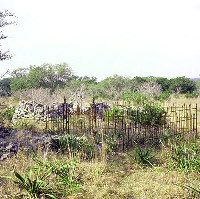
A wrought-iron fence is a distinctly
German element in the otherwise rustic cemetery. The
occupant of the grave is unknown. Photo by Susan Dial.
|
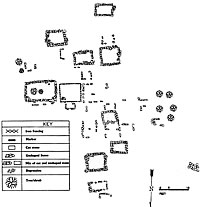
Plan map of cemetery drawn by TARL
archeologists during survey. Some 30 graves may lie
in the cemetery, based on size of the rock-walled enclosures
and other evidence of individual burials.
|
|
Cemeteries springing from the southern traditions
have been described by cultural geographer Terry Jordan
as "a mixture of order and chaos."
|

The grave of Birdie Rose is enclosed
by a cut-stone cairn. Photo by Tom Hester.
|
|
In the hilly uplands of Barton Creek, low rock
enclosures and an ornate wrought iron fence stand out in odd
relief amid an otherwise stark landscape. Yucca, scrub oak,
and native grasses have overtaken this small cemetery, moving
in and taking hold where cattle and goats have nudged the
stone walls over.
At times in the past, this somewhat desolate
place saw family members gather to bury a loved one, bringing
the coffin on horse-drawn wagon over rocky roads. Nine-year
old Birdie Rose was laid to rest here in 1879 by her family—
Swedish immigrant Charles Rose, who served as postmaster in
Cedar Valley, mother Rebecca, a native of Arkansas, and four
brothers and sisters. Nearby is the grave of the ill-fated
Phillip Doeppenschmidt, who according to local lore, was kept
locked up on the front porch of his family's loghouse. Census
records for 1880 list him as insane and an invalid; he died
a year later at the age of 61. Missouri native Issac Hale
came to the Texas Hill Country to farm the land, but died
at the age of 30 leaving behind a wife and two small sons.
Fred Haas, who grew up in a nearby log house,
recalls that a funeral in the Hill Country around the turn
of the twentieth century might, at best, involve a circuit-riding
preacher. There were, of course, no funeral homes, and bodies
were generally laid out on a table at home prior to burial.
Although perhaps as many as 30 other individuals
were buried in this small cemetery, their identities and stories
have been lost or forgotten. The few existing gravestones,
including those for the three accounted for above, have weathered
now almost beyond recognition. There may have been wooden
markers in the past, but these, too, have vanished. But in
the cemetery itself—in its layout and general plan—we
can see traces of the people who were once here, a microcosm
of the traditions and cultures brought into the Hill Country.
The single decorative wrought-iron enclosure
is distinctly German in style; similar grave fences can be
seen in early communities such as Fredericksburg. But unlike
German cemeteries, with their more rigid organization and
family hierarchy (children were buried in a children's section
apart from the parents), there is little patterning in the
graves in this hillside cemetery. More likely, it evolved
over a brief period of time as families of several different
backgrounds came together in a community effort.
There are low walls of stone—some carefully
cut, others unshaped—enclosing what clearly are multiple
graves. A few of the larger may contain as many as five or
six graves, and these may be family plots. There is no evidence
that these were capped with a stone slab, as were similar
graves in other communities of the period. Although legend
claims the walls were erected to keep Indians and wild animals
from disturbing the graves, the more likely explanation is
that they were built to keep out grazing animals.
Cemeteries springing from the southern traditions
have been described by cultural geographer Terry Jordan as
"a mixture of order and chaos." The single measure
of order in these cemeteries, he tells us, is an unfailing
orientation of the graves to an east-west axis; a design anticipating
Judgement Day, when the dead might rise facing Christ, as
symbolically represented by the sun. In spite of the lack
of markers and the deterioration of many of the enclosures,
the orientation of the graves in this small Barton Creek cemetery
is quite clear.
|
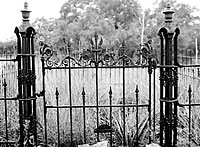
Ornate detailing of the gate on the
wrought-iron fence is similar to graveyard furnishings
in Fredericksburg and other German Hill Country communities.
Photo by Susan Dial.
|

"Not lost but gone before;"
marker of nine-year-old Birdie Rose, who died in 1879.
Photo by Tom Hester.
|
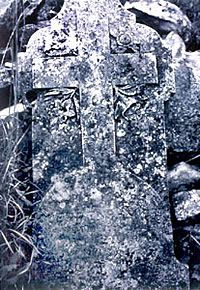
Headstone of Phillip Doeppenschmidt.
A native of Bavaria, he married a French woman, Caroline
Cezeaux, and moved to her Hill Country land. Their log
house (see the Doeppenschmidt-Haas
House) has now been restored by the current landowners. |
|
